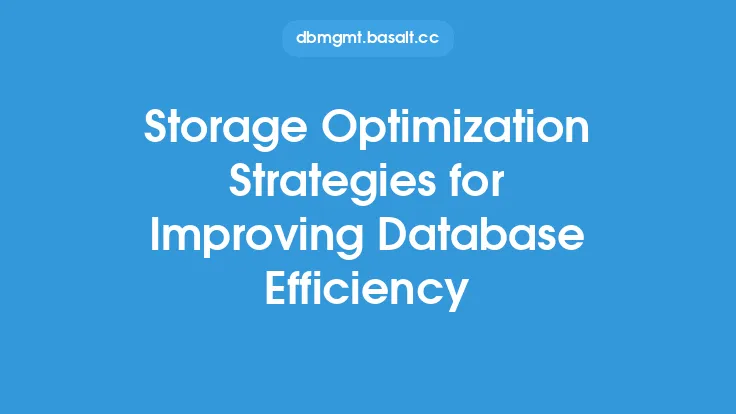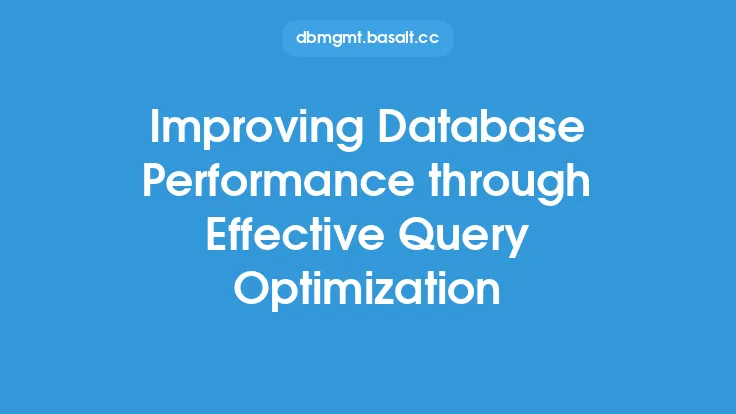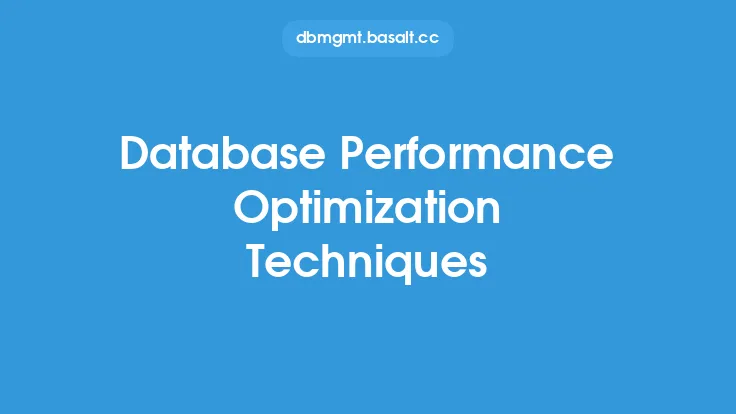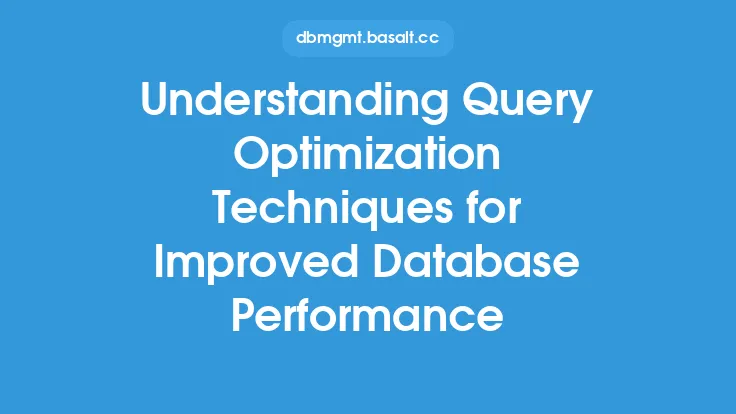Database storage optimization is a critical aspect of database performance optimization, as it directly impacts the speed and efficiency of data retrieval. When a database is optimized for storage, it can significantly improve the overall performance of the system, leading to faster query execution, reduced latency, and increased throughput. In this article, we will delve into the various database storage optimization techniques that can be employed to improve data retrieval speed.
Introduction to Database Storage Optimization
Database storage optimization involves a set of techniques and strategies that aim to reduce the amount of storage required to store data, while also improving the speed and efficiency of data retrieval. This can be achieved through a combination of data compression, indexing, caching, and data partitioning, among other techniques. By optimizing database storage, organizations can reduce their storage costs, improve data retrieval speeds, and enhance overall system performance.
Indexing and Query Optimization
Indexing is a crucial aspect of database storage optimization, as it enables the database to quickly locate and retrieve specific data. An index is a data structure that improves the speed of data retrieval by providing a quick way to locate specific data. There are several types of indexes, including B-tree indexes, hash indexes, and full-text indexes, each with its own strengths and weaknesses. By creating the right indexes on the right columns, organizations can significantly improve query performance and reduce the time it takes to retrieve data.
Query optimization is also critical to improving data retrieval speed. This involves analyzing and optimizing the queries that are executed against the database to ensure that they are running efficiently. This can be achieved through techniques such as query rewriting, indexing, and caching. By optimizing queries, organizations can reduce the amount of time it takes to retrieve data, improve system performance, and enhance overall user experience.
Data Partitioning and Distribution
Data partitioning and distribution are essential techniques for optimizing database storage and improving data retrieval speed. Data partitioning involves dividing large tables into smaller, more manageable pieces, based on a specific criteria such as date or region. This can improve query performance by reducing the amount of data that needs to be scanned, and can also simplify data management and maintenance.
Data distribution, on the other hand, involves spreading data across multiple servers or storage devices to improve performance and availability. This can be achieved through techniques such as sharding, replication, and load balancing. By distributing data across multiple servers, organizations can improve data retrieval speeds, increase system availability, and enhance overall performance.
Caching and Buffering
Caching and buffering are critical components of database storage optimization, as they enable the database to quickly retrieve frequently accessed data. Caching involves storing frequently accessed data in a fast, accessible location, such as RAM or a caching layer. This can improve query performance by reducing the time it takes to retrieve data from disk.
Buffering, on the other hand, involves storing data in a temporary location, such as a buffer pool, to improve performance and reduce the load on the database. By caching and buffering frequently accessed data, organizations can improve data retrieval speeds, reduce latency, and enhance overall system performance.
Storage Media and Configuration
The type and configuration of storage media can significantly impact database performance and data retrieval speed. Traditional hard disk drives (HDDs) are being replaced by faster, more efficient storage media such as solid-state drives (SSDs) and flash storage. These newer storage media offer faster read and write speeds, lower latency, and higher throughput, making them ideal for database storage.
The configuration of storage media is also critical to optimizing database storage. This includes configuring the storage media to optimize performance, such as configuring the disk layout, setting the block size, and optimizing the file system. By optimizing the storage media and configuration, organizations can improve data retrieval speeds, reduce latency, and enhance overall system performance.
Database Configuration and Tuning
Database configuration and tuning are essential to optimizing database storage and improving data retrieval speed. This involves configuring the database to optimize performance, such as setting the buffer pool size, configuring the query optimizer, and optimizing the locking mechanism.
Database tuning involves analyzing and optimizing the database configuration to ensure that it is running efficiently. This can be achieved through techniques such as performance monitoring, query analysis, and configuration adjustments. By configuring and tuning the database, organizations can improve data retrieval speeds, reduce latency, and enhance overall system performance.
Best Practices for Database Storage Optimization
To optimize database storage and improve data retrieval speed, organizations should follow best practices such as:
- Regularly monitoring and analyzing database performance to identify bottlenecks and areas for improvement
- Optimizing database configuration and tuning to improve performance
- Implementing indexing, caching, and buffering to improve query performance
- Using efficient storage media and configuration to improve data retrieval speeds
- Partitioning and distributing data to improve query performance and simplify data management
- Regularly maintaining and updating the database to ensure optimal performance
By following these best practices, organizations can optimize their database storage, improve data retrieval speeds, and enhance overall system performance.





